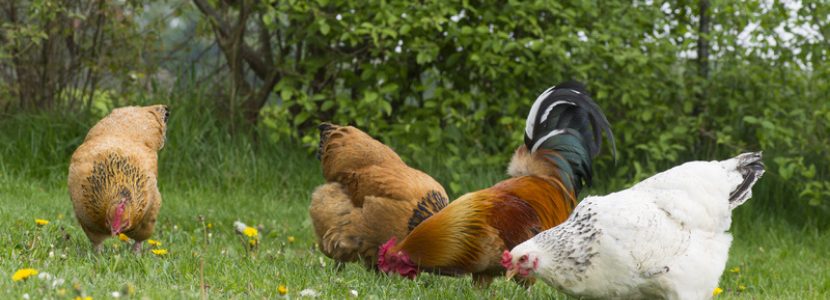Free range chickens’ intestinal microbial population is a topic of interest for the poultry industry and more specifically for those carrying out this kind of production system.
Outdoor broiler production faces several of the same problems as outdoor laying hens, including predator threats, bird health, and environmental exposure.
Sossidou et al. (2015) have suggested that slow-growing poultry breeds are preferred for this type of production. This is due to the fact that they are more adaptable to environmental conditions associated with prolonged pasture occupation thanks to their growth rate, skeletal development, behavioral characteristics, and a well-developed immune system.
Fast-growing broiler breeds can be ready for the market in as little as 7 weeks, while slow-growing breeds may require up to 12 weeks before entering markets.
In addition, Sossidou et al. (2011, 2015) noted that there may be benefits for animal welfare and lower nutritional requirements for slow-growing breeds in grasslands vs. fast-growing breeds under these same conditions.
Food safety concerns have also been considered with broiler production in the wild. The main foodborne pathogens associated with poultry are Campylobacter and Salmonella
The colonization route of foodborne pathogens in the gastrointestinal(GI) tract and systemic invasion is presumably similar to what occurs in conventional poultry (Shi et al. , 2019). This certainly depends on host factors, such as intermittent dietary intake which is potentially experienced in free range grazing.
Since antibiotics are generally excluded in free range production, the occurence of antibiotic resistance in microorganisms isolated from birds produced under these conditions would presumably be less frequent.
Factors such as:
Diet
Race
The age of birds
And housing conditions
may exhibit a potential influence on the development of the GI tract microbial consortium in broilers.
These types of dietary differences between conventionally raised broilers and “Free Range” chickens may also have a distinctive influence on the respective GI tract microbiota.
Age can affect the diversity of the gut microbiome in poultry, even when diet does not. [register]
| For example, Ocejo et al. (2019) compared one fast-growing breed of broilers raised under conventional conditions for more than 42 days (Group 1), with a breed of slow-growing chickens raised in free-form for 84 days (Group 2).
They fed the chickens in Group 1 with an starter ration followed by a growth-completion ration. Group 2 chickens were fed a corn diet combination supplemented with soybean and wheat combinations. They were also given access to pasture fodder. Both groups of birds were slaughtered at different incremental times during their respective growth periods. Cecal samples were collected for microbiome analysis. Results: When microbiome populations were distinguished for the respective production systems, no dietary influences were detected, but age-related differences occurred in both types of systems.
Conclusion: Authors concluded that while age ultimately affected the development of the cecal microbial community overall, the outdoor group generated a richer and more complex cecal microbial population than conventionally bred birds. |
Poultry production systems involving free range production of broilers and laying hens continue to be of public interest. As they represent attractive alternatives to commercial poultry products.
- However, practical challenges remain regarding the operational management of farms.
In addition to predator threats, food security and general bird health problems, economic concerns related to the acquisition of sufficient raw materials, considered acceptable for alternative production systems are an ongoing problem.
Establishing reliable food supplies requires certain level of nutritional standardization in order to be able to evaluate non-traditional food sources.
- However, this becomes complicated due to variable factors such as breed differences, environmental impact, and different dietary management approaches.
Part of the difficulty lies in acquiring accurate estimates of bird feeding activity and the corresponding contribution that fiber consumption makes to birds’ dietary needs.
Specific food additives have been examined in Free Range broilers in an attempt to modulate the microbial population of the GI tract in ways that benefit the host. There is a wide range of different types of chemical compounds, organic acids, phytobiotics and various biological additives, bacteriophages, probiotics and prebiotics, which have potential or have been directly examined for use as food additives in free-range chickens (Shi et al. , 2019).
- Phytobiotic products, can be particularly attractive as birds are grazing forages and their microbial populations must adapt to a more efficient fiber use.
- Prebiotics are characterized by being complex carbohydrates that cannot be used by the bird but can be hydrolyzed and fermented by the intestinal microbial population. Therefore, they have drawn interest as feed additives for free range broilers (Ricke, 2018; Shi et al., 2019).
Microbiome sequencing and characterization of GI tract microorganisms from birds raised in free-range environments has contributed to a better understanding of the differences associated with breed and nutritional responses associated with alternative poultry production.
While diet and the environment may be influential factors, it appears that bird maturity and growth rate are critical factors which contribute to changes in GI tract microbial diversity.
Conclusions
As slow-growing breeds become increasingly popular, further microbiome characterization studies will be necessary for these breeds. In order to highlight potential differences and determine the contribution of GI tract microorganisms in overall host nutrition and well-being.
In addition, most microbiome studies in poultry have focused on cecal microbial populations. Therefore, further characterization of other GI tract compartments are required in order to assess the contributions of these microorganisms.
As more information about the microbiome is known and microbial metabolic network analysis is applied, it should be possible to elucidate the contributions of individual members of GI tract microbial consortium. As well as determining the levels of GI tract functions, such as fiber degradation and the contribution of forage grazing to the overall set.
Source: https://www.ncbi.nlm.nih.gov/pmc/articles/PMC7587794/
[/register]
